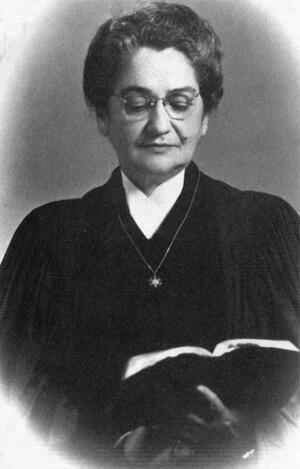Death of Paula Ackerman, “America’s first Lady Rabbi”
Paula Ackerman, reading from a religious text.
When Paula Ackerman's husband, William Ackerman, died in 1950, his congregation, the Reform Temple Beth Israel of Meridian, Mississippi, requested that she succeed him. Thus, Paula Ackerman became the first female spiritual leader of a mainstream Jewish congregation in the United States.
Institution:The Jacob Rader Marcus Center of the American Jewish Archives, Cincinnati, OH.
Paula Ackerman’s life in Pensacola, Florida began with compromises. Her father planned to provide a Hebrew education only for his sons; when his daughter showed a desire to study, he eventually relented and hired an Orthodox rabbi to supplement their weekly religious education. A valedictorian of her high school class in 1911, she was offered a scholarship to Sophie Newcomb College in New Orleans, where she sought to pursue a medical career, but when her father disapproved, she declined it. Her family’s financial needs required instead that she teach at a local high school and give music lessons, as well as working in the local synagogue as choir director
It was while she led the congregation’s choir that she met Dr. William Ackerman, the local rabbi, who courted her for seven years. Married in 1919, the two moved to Meridian, Mississippi in 1924, the place that would become her family’s base and her spiritual home for more than 50 years.
Meridian’s Temple Beth Israel was a Reform congregation with a membership of approximately 150 families. There, Paula Ackerman taught preconfirmation classes and led religious services when her husband was ill or out of town, in addition to fulfilling the social and outreach roles expected of the wife of a rabbi.
When her husband died in November 1950, the congregants requested that Paula take his place. She thought they should choose a more experienced rabbi, one more familiar with greater Judaic knowledge. But after receiving informal permission from the president of the Union of American Hebrew Congregations (the congregational wing of the Reform Movement), she accepted their invitation and stepped into the role in January 1951, viewing the invitation as both a divine call to service and an opportunity “to plant a seed for enlarged activity for the Jewish woman.” When the president reconsidered his decision, Temple Beth Israel’s president informed him that in the eyes of “practically all of the members of our congregation she is qualified, and we want her.” Attracting international attention from the press, she was erroneously labeled “America’s first Lady Rabbi.”
Ackerman achieved the distinction of becoming the first woman to assume religious leadership of a mainstream American Jewish congregation, serving until the fall of 1953. In 1986, at a special ceremony held at The Temple in Atlanta, the Union of American Hebrew Congregations formally recognized her pioneering contribution to Jewish communal life. She died in Thomaston, Georgia on January 12, 1989.
Sources: The Rabbi's Wife: The Rebbetzin in American Jewish Life, Shuly Schwartz, NYU Press, 2006; Four Centuries of Jewish Women's Spirituality: A Sourcebook, edited by Ellen M. Umansky, Dianne Ashton, Brandeis, 2008.



